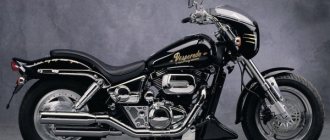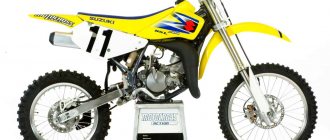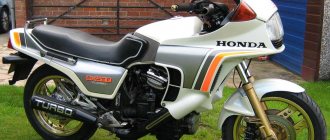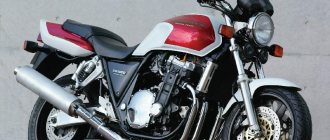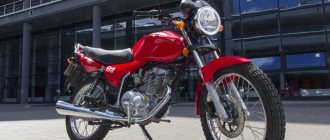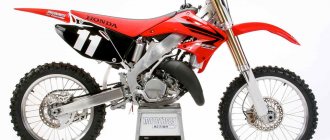Description
The Suzuki SV400 series of road motorcycles appeared at the end of 1998 and was aimed at the domestic Japanese market. The Suzuki SV650 model was exported to Europe, North America and Oceania. Both models are almost identical in appearance, but have a number of key differences. Firstly, in engine volume (399 cm³ versus 645 cm³). Secondly, in the braking system (the first SV400 models had only one brake disc at the front; the SV400 rear brake was a 2-piston). Thirdly, by generation (since 2003, the SV650 received a powerful restyling and began to differ in appearance from the SV400).
Like the older versions, the Suzuki SV400 model series largely copied the European concept of road motorcycles, and in particular, the concept of the Ducati brand. The TL1000 experience at one time showed the promise of this area and demonstrated noticeable market interest in this class of equipment. In turn, the SV series differed from the Ducati Monster in its simpler equipment, which was expressed not only in the engine, but also in the chassis (simple suspension, inexpensive 2-piston brakes).
The Suzuki SV 400 was based on a 2-cylinder V-shaped (90°) liquid-cooled engine with a volume of 399 cm³, producing a standard (for 400 cc models on the Japanese market) 53 hp. power and 41 Nm of torque. Unlike models with in-line 4-cylinder engines of the same displacement, the SV400 had significantly better traction in the low and medium speed zone, which increased ride comfort. In addition, the motor itself was narrow and almost completely fit into the dimensions of the frame. Due to the arrangement of the cylinders with a pronounced forward inclination, such an engine is often called an L-shaped engine.
Other features of the Suzuki SV 400 include an aluminum tubular frame, simple suspension in the form of a classic telescopic fork and monoshock absorber, disc brakes, a 6-speed gearbox, a 16-liter fuel tank and 164 kg of dry weight.
Advantages of a motorcycle
It is quite difficult to evaluate the flagships of the motorcycle industry of the mid-90s in our high-tech times, since even the ideal bike of those times will be inferior to modern models in most characteristics. However, even a quick review of the Suzuki RF 400 will show that this Japanese car can easily compete with its younger brothers.
Any photo of the Suzuki RF 400 at first glance makes you take a closer look at the motorcycle. The fact is that the RF received the base from a variation of the motorcycle designed for 600 cc. This greatly improves the comfort and handling of the bike.
Japanese engineers also deserve a kind word for the frame design. It is made of steel, which has a beneficial effect not only on its rigidity and reliability of the bike, but also on its final cost.
Generally speaking, the dimensions of the Suzuki RF 400 are well thought out. In addition to the bike driver himself, the passenger, whose seat is highly ergonomic and comfortable, can also feel this.
Main modifications of the Suzuki SV400:
Suzuki SV400 is a regular naked version. Features a classic round headlight and a classic steering wheel.
Suzuki SV400S - sports version. It was distinguished by a plastic front fairing and a double headlight in a sporty style, clip-ons and higher footrests. This modification was more popular on the market.
2006 was the last year of production of the SV400, after which it finally left the market. In 2009, it was replaced by a new model - Suzuki Gladius 400.
Design
The appearance of the Suzuki is almost perfect and is somewhat reminiscent of the design of the Honda. The slender appearance reveals some of the details, which is why it is given the “naked” style. Some people will like this move, while others prefer parts completely covered with plastic. Among fans of this model, this feature is considered the highlight of the motorcycle. After all, once upon a time road bikes were produced without any plastic protection at all. The neoclassical design is sure to attract attention on the roads.
The CB 400 model is produced not only in the style of old road motorcycles, but also with a hint of sporty style. Suzuki SV 400S is made in the style of motorcycles with large engine volumes. More plastic, more speed and power - that's what the letter S in the model name means. The double headlight and more compact windshield give it a slightly predatory appearance. The characteristics of the engine and other parts remained the same as those of the SV 400. The sporty landing makes the oncoming air flow insensitive even at high speeds.
Brief history of the model
1998 - start of production and sales of Suzuki SV400. Model: Suzuki SV400; Suzuki SV400S (Japan). Frame number: VK53A-100001~. Factory designation: SV400W; SV400SW.
1999 - model not produced. 2000 - Only S version available. The model gets dual disc brakes at the front. Model: Suzuki SV400S (Japan). Frame number: VK53A-101953~. Factory designation: SV400SY.
2001 - no significant changes. Model: Suzuki SV400S (Japan). Frame number: VK53A-500001~. Factory designation: SV400SK1.
2002 - model not produced. 2003 - resumption of production of the regular version of the SV400. The S version is temporarily not produced. The front fork gets preload adjustment. Model: Suzuki SV400 (Japan). Frame number: VK53A-500551~. Factory designation: SV400K3.
2004 - resumption of production of the S-version. This year's models are available with a black frame and wheels. The "Suzuki" name on the fuel tank is replaced with an "S" logo. Model: Suzuki SV400; Suzuki SV400S (Japan). Frame number: VK53A-500947~; VK53A-500957~. Factory designation: SV400K4; SV400SK4.
2005 - no significant changes. Model: Suzuki SV400; Suzuki SV400S (Japan). Frame number: VK53A-501409~; VK53A-501419~. Factory designation: SV400K5; SV400SK5.
2006 is the last year of production. Model: Suzuki SV400; Suzuki SV400S (Japan). Frame number: VK53A-501900~. Factory designation: SV400K6; SV400SK6.
What's good and bad about it?
Like any technology, the vehicle in question has both positive and negative sides. Advantages include:
- Good motor.
- High dynamics.
- Brisk acceleration.
- Unique appearance.
- A solid base is what the frame plays.
- A price accessible to a large number of buyers.
The motorcycle is quite aggressive and tends to accelerate with a jerk. Beginners need to remember that the described vehicle has short gears. When driving in urban conditions, you will have to switch between them often.
This model is well suited for experienced motorcyclists who feel confident on the road surface when driving at high speed. The disadvantage is that the vehicle was originally designed for Japanese citizens. This leads to the following disadvantages:
- Short and rather low frame. Such features may cause inconvenience to a tall person.
- There is no way to correct the situation using tuning. There is nowhere to move the racks and it is also impossible to change the landing.
- The aggressiveness mentioned above is a disadvantage if we are talking about a driver who does not have the necessary experience to use it correctly.
From the above we can conclude that the Suzuki gsf 400 bandit does not cope well with the role of the first motorcycle for a novice driver.
Specifications
| Model | Suzuki SV 400 |
| Motorcycle type | naked |
| Year of issue | 1998-2006 |
| Frame | aluminum tubular |
| engine's type | 2-cylinder, 4-stroke, V-shaped 90° (L-shaped) |
| Working volume | 399 cm³ |
| Bore/Stroke | 72.0 x 49.0 mm |
| Compression ratio | 11.8:1 |
| Cooling | liquid |
| Number of valves per cylinder | DOHC, 4 valves per cylinder |
| Fuel supply system | Carburetor, 2x Mikuni BDSR36 |
| Ignition type | transistor |
| Maximum power | 53.0 hp (39.0 kW) at 10500 rpm |
| Maximum torque | 41.0 Nm (4.2 kg*m) at 8000 rpm |
| Transmission | 6-speed |
| type of drive | chain |
| Front tire size | 120/60ZR17M/C (55W) |
| Rear tire size | 160/60ZR17M/C (69W) |
| Front brakes | 1 disc, 2-piston caliper – SV400 / SV400S (1998) 2 disc, 290 mm, 2-piston caliper – SV400 / SV400S (2000-2006) |
| Rear brakes | 1 disc, 240 mm, 2-piston caliper |
| Front suspension | 41 mm telescopic fork (non-adjustable), 130 mm travel – SV400 / SV400S (1998-2002) 41 mm telescopic fork (preload adjustable), 130 mm travel – SV400 / SV400S (2003-2006) |
| Rear suspension | Pendulum with monoshock absorber (preload adjustment), stroke - 125 mm |
| Motorcycle length | 2070 mm |
| Motorcycle width | 750 mm – SV400 740 mm – SV400S |
| Motorcycle height | 1060 mm – SV400 1130 mm – SV400S |
| Wheelbase | 1430 mm – SV400 1420 mm – SV400S |
| Seat height | 785 mm |
| Minimum ground clearance (clearance) | 140 mm |
| Acceleration to 100 km/h | 5.3 sec |
| Maximum speed | 180 km/h |
| Gas tank capacity | 16.0 l |
| Motorcycle weight (dry) | 164 kg – SV400 168 kg – SV400S |
Chassis and brakes
The V-twin engine was not praised only by the lazy. Quiet and responsive, it helps you enjoy your ride. Aluminum cylinders, which have a nickasil coating, give smooth running. It is this material that has thermal expansion identical to that of pistons. As a result of this selection of materials, the gap between the pistons and the cylinder walls remains equally minimal throughout the entire operation of the engine. And this allows the Suzuki to gracefully maneuver among traffic and fit into corners perfectly.
The engine has a low noise level, sometimes you can easily forget that you have 53 horsepower hiding under the hood. You can accelerate to 180 km/h in a couple of minutes. A fairly rigid chassis allows you to overcome road obstacles without harm. And the SV 400 itself drives equally well on both asphalt and dirt surfaces. Suzuki SV 400 is perfectly balanced for both extreme driving and leisurely trips every day. The responsiveness of the engine makes it an ideal first bike for a beginner. But even in the hands of a professional, it will not remain unused and will be able to reveal all its technical characteristics.
Main competitors
The Suzuki 400 SV has few worthy competitors among 400 cc motorcycles. The main ones are the Kawasaki ZZR 400 and the Honda CB 400. The main target audience of all of the above models are drivers with little driving experience or those who are completely satisfied with the given engine size.
Compared to Kawasaki, problems arise with Suzuki much less. Better cornering, lighter weight, no engine problems - all this eliminates the need to run to a car repair shop after every third trip. The smaller number of gearshifts in the SV 400 allows you to spend less time paying attention to the gearbox and more time on the road. The engine power allows you to use only 2/3 of the operating range even at high speeds, while the other two models have to turn the knob to the limit. But Honda is ahead of Suzuki in the braking system. What do the owners of the Suzuki SV 400 say? You can read reviews about it below.
Buyers' opinion
Owners of the Suzuki Skywave 400 maxi-scooter, whose reviews are generally positive, note primarily the comfortable feeling when driving on smooth roads, a smooth ride and silent engine operation. However, all buyers agree that on rough roads the level of comfort decreases significantly. The front wheel transmits shocks through the handlebars, which make it difficult to control the scooter. And the rear suspension throws the passenger up, and this happens chaotically. To avoid shaking, you have to reduce the speed to a minimum and move, carefully avoiding bumps and irregularities.
Otherwise, the owners do not see any shortcomings. The engine power is more than sufficient, its throttle response allows you to make a jerk if necessary and move forward if the road situation requires it. Or, conversely, stop in time, since the scooter’s ventilated disc brakes are highly efficient.
Reviews about SV 400
Reviews from owners of road motorcycles from the Suzuki brand only confirm the quality and durability of the products of the world-famous Japanese concern. Many claim that it is sometimes impossible to distinguish the 400 cc version from the more serious “six hundred”. The center of gravity is reduced in such a way that control is as comfortable and dynamic as possible. Instant response to gas operation, excellent engine thrust. The only thing that upsets owners is engine misfires, which remind them of the class of the motorcycle. Some about troit the engine. To avoid such troubles, professionals recommend using only high-quality gasoline (preferably no lower than 95) and checking the filter element and adjustments. And as for the Suzuki SV 400: maintenance and repairs can get even a 1998 model back on its feet, which will then serve you for many more years.
The rigid frame frame, made of aluminum, is compared by motorcycle owners with those that are equipped with 650 cc motorcycles. She can easily withstand all the hardships of the racing journey.
In general, the entire motorcycle is made with special care, high quality and neat. Many people recommend it for city use, arguing that it performs well both in traffic jams and on highways. The only thing that brings some fly in the ointment is the brake system. Overall not bad, but has a rather weak rear brake. And when braking sharply at speeds above 150 km/h, you should be careful: the front 2-disc brake may not be enough.
Price range
Due to its excellent characteristics, the Suzuki SV 400 has a fairly high price for its class. The average cost of a road bike ranges from 110-220 thousand rubles. A significant sum for a used motorcycle. You can also find cheaper specimens on sale, but their condition leaves much to be desired. If you know how to repair and revive motorcycles, you won’t find a better option.
If you feel sorry for paying that kind of money for a used model, think about how many of its cheaper “comrades” it can outlast. A motorcycle with true Japanese quality will become a faithful companion on the roads and will not let its owner down for many years.
